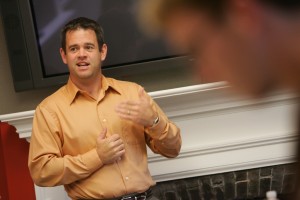
Professor Joshua Sanborn
While checking into a hotel in Latvia, Joshua Sanborn got a lesson in global politics from an unlikely source – the front desk clerk.
“He spoke Russian, German, French, English, and Latvian,” says Sanborn, professor of history and chair of the Russian and East European Studies program, who was in Latvia doing research for a book. “It was a reminder of how fluid and fluent so many young people are in the world, and I think it’s important for American students to be the same way.”
Sanborn isn’t talking just about languages. American students need to be exposed to other cultures and have a knowledge of world history so they can understand events in a broader context and respond to them more thoughtfully, he says.
At Lafayette, the core introductory history course is History of the Modern World.
“One of our key functions is to get people to look beyond themselves and their experiences and understand that people have other ways of doing things and our way isn’t necessarily better,” he says. “I believe that our histories – individual, communal, national, and global – shape us, whether we are conscious of it or not. We understand more about ourselves and about others when we know those histories.”
It was the fate of the world that inspired Sanborn to take courses in international relations and arms control at Stanford University in California.
“I grew up at the end of the Cold War in the ’80s and I was scared to death of a nuclear war,” he says. “I wanted to prevent that.”
After declaring a major in Russian history his junior year, Sanborn participated in a student exchange with Novosibirsk State University, one of the Soviet Union’s premier universities, located in the heart of its defense industry in Siberia. It was 1990, Mikhail Gorbachev was in power, and glasnost, which ushered in a new era for the Soviet Union by calling for transparency in government and allowing freedom of speech, was in full force.
“It was a really different place, and it was exciting because so much change was going on,” says Sanborn, who earned his Ph.D. in Russian history from the University of Chicago and as part of his studies lived in Moscow for a year in the 1990s. “You felt a sense of specialness.”
Last year, Sanborn and Ida Sinkevic, associate professor of art, took 19 students on a one-week trip to Moscow and St. Petersburg as part of a course on the country’s culture, history, and art. When they returned, students presented research projects and topics ranging from the history of vodka to mail order brides to the architecture of Russian churches.
Often, our world view is shaped by family, friends, and the media, but exposure to different cultures makes us “more respectful and tolerant of different norms and values,” says Sanborn, who not only teaches but conducts archival research, writes articles and books, and critiques the work of other professional historians.
Research adds depth and nuance to his understanding of the human experience, he says.
“Just as one of the real benefits of a liberal arts education is that students learn to think more broadly and substantively about the world they live in, so too is it crucial for professors to be engaged in high-level scholarship so that they become more complex thinkers and effective communicators,” he says. “I know that I am a better professor on a daily basis thanks to the intellectual work I perform as a scholar.”

1 Comment
Comments are closed.